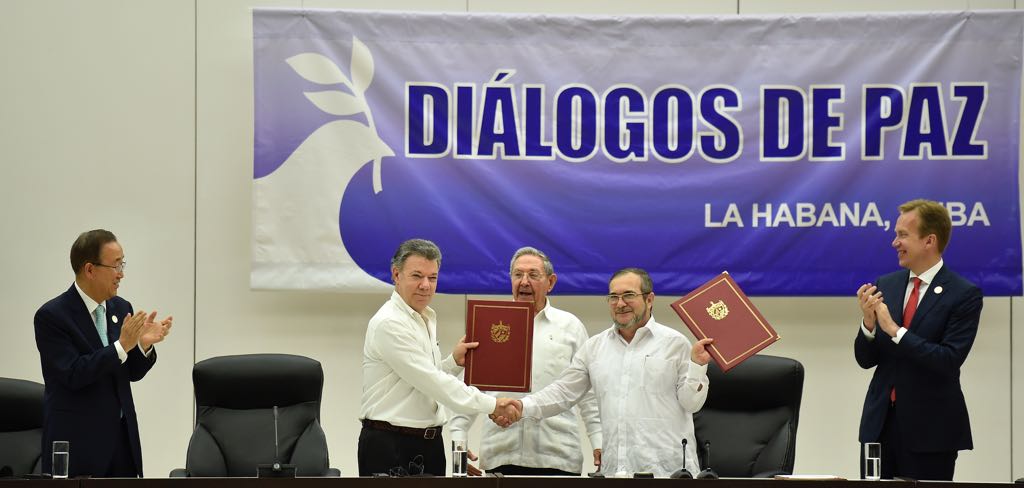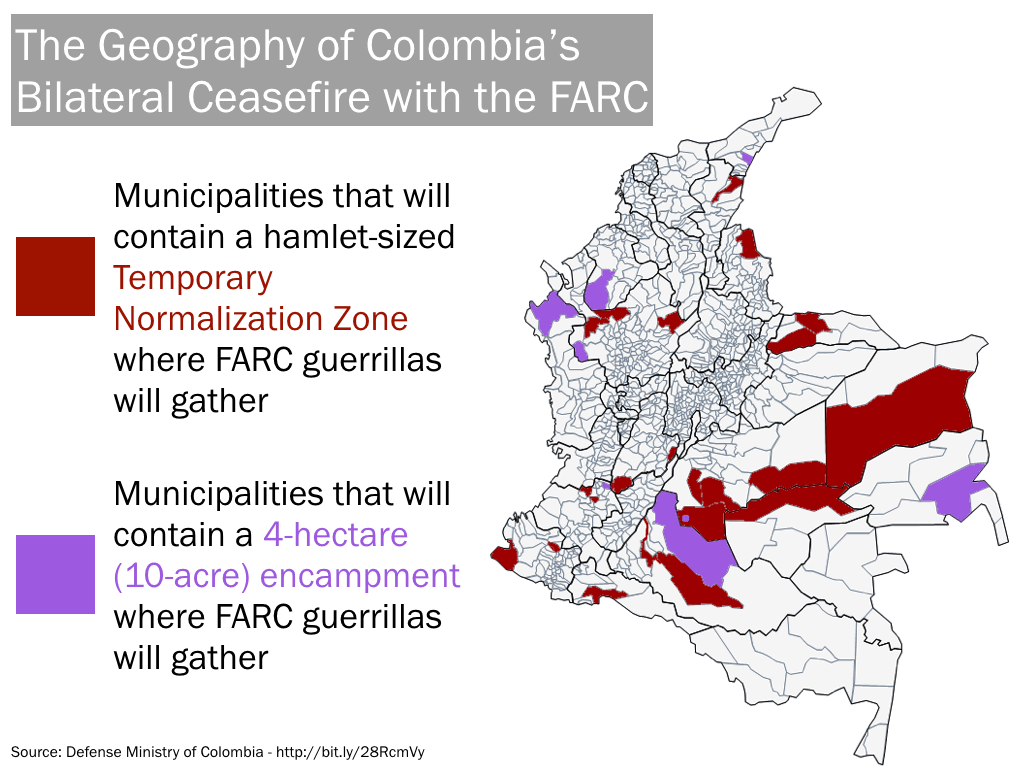(This summary was updated and corrected on June 24 to reflect new information.)
The accord agreed today, for “A Bilateral and Definitive Ceasefire, Cessation of Hostilities, and Laying Aside of Weapons,” closes the fifth of five substantive items on the FARC-government negotiating agenda. It sets out a roadmap for disarming and demobilizing the FARC after a final peace accord is signed. It foresees a swift process: a full turnover of guerrilla weapons within six months.
This is a tremendous milestone. What remains between now and a final, conflict-ending peace accord are details. Some of these will be thorny, and may require weeks or even a few months to unravel. But the hardest parts of the FARC peace process are now in the past.
Here is a quick English summary of the remarkable agreement announced today.
Timetable
- The bilateral ceasefire and “leaving aside” of weapons will begin at the date and hour of the signing of a final accord. This date may be weeks or months from now, as the draft accords reached since 2013 have at least a few dozen points on which the parties could not reach final agreement.
- The day after a final peace accord, Colombia’s security forces will redeploy in a way that facilitates the FARC membership’s movement to the 23 “Temporary Hamlet Zones for Normalization” described below. The government and FARC will provide these zones’ geographic coordinates to the UN monitoring mission (which is also described below).
- Five days after a final peace accord, the FARC’s units will begin to move to these zones, following routes agreed upon between the government and FARC. The monitoring and verification mission will oversee this process, including the movement of the guerrillas’ individual weapons.
- Once the FARC turns in a list of the combatants present in each Temporary Hamlet Zone, the government will suspend all outstanding arrest warrants for them. Those who can be amnestied—who do not face allegations of serious human rights crimes—may begin their “process of reincorporation into civilian life.”
- Between seven and thirty days after a final peace accord, the FARC’s weapons stockpiles, as well as guerrilla militias’ arms and all explosives, must be moved to the Temporary Hamlet Zones under the supervision of the verification and monitoring mission.
- Within 180 days, as discussed below, the UN mission should have control over all of the FARC’s weapons.
Concentration of Guerrilla Fighters
- The parties will establish 23 “Temporary Hamlet Zones for Normalization” (Zonas Veredales Transitorias de Normalización), with 8 encampments inside each and an additional 8 encampments elsewhere in the country. These zones’ location has not been made public, if it is even decided yet. These zones and encampments will be located in municipalities listed in a June 24 Defense Ministry communiqué and mapped out below.
- Each Temporary Hamlet Zone will be as large as a hamlet or vereda, an administrative division that is usually quite small (most of Colombia’s 1,100 counties have a few dozen veredas). Each must be accessible by road or river. Each may be expanded or reduced by mutual accord if necessary.
- Each zone will be surrounded by a 1-kilometer buffer zone, in which neither the security forces nor the FARC may be present (except for those participating in the verification and monitoring mission). Military aircraft may not fly below 5,000 feet above the zones.
- The FARC will be responsible for its combatants within each zone. Any FARC members who leave the zone must do so unarmed and out of uniform.
- The FARC cannot use the zones “for demonstrations of political character.”
- Any unarmed civilian government authorities within these zones will be able to continue performing their duties without interference. They may enter any part of the zones, except for the encampments within them, where the FARC will be lodged. No civilians may enter the encampments at any moment.
- If the police or other armed government authorities need to enter a Temporary Hamlet Zone for some reason, they must arrange it beforehand with the verification and monitoring mechanism.
- The FARC may provide education and other orientation to its fighters within these zones, while the government may perform other services (like health care or issuing ID cards) necessary for their reintegration into civilian life.
- During the period in which the FARC are concentrated in these zones, 60 guerrillas will have permission to travel anywhere in the country to carry out tasks related to the peace accord. For each Temporary Hamlet Zone, 10 guerrillas will be able to travel anywhere in that department (province) to carry out such tasks. While traveling, these guerrilla representatives will have protection. Before they do so, they much store their weapons in containers overseen by the verification mission.
Monitoring and Verification
- Members of the government, the FARC, and a UN mission approved by a January Security Council resolution will make up a tripartite monitoring and verification mechanism. This mechanism will be divided into eight regions and a larger number of local units—including one for each Temporary Hamlet Zone. The mechanism will have unlimited access to each of these zones.
- The international component will be a UN mission made up of unarmed political observers. It will mainly be made up of members of Community of Latin American and Caribbean States (CELAC) countries. This international component will preside over all of the tripartite mechanism’s units, and will settle disagreements, issue recommendations, and publish reports.
- This mechanism will verify that the parties are following the rules of the ceasefire. It will investigate incidents or violations, and will present recommendations to the government and FARC for how to prevent or correct them.
“Leaving Aside” (Dejación) of Weapons
- The UN mission will receive the totality of the FARC’s armaments, which will be used to build three monuments.
- “Leaving aside” weapons will consist of eight steps:
-
- registration of the quantity and types of weapons brought into the Temporary Hamlet Zones;
- identification of each individual’s weapons (the accord makes a distinction between the weapon each fighter carries, and additional weapons in guerrilla stockpiles);
- monitoring and verification of weapons being carried by guerrillas in the encampments within the zones;
- turnover of weapons to the UN mission;
- storage or warehousing (almacenamiento) of the collected weapons, in containers within the zones that only the UN mission may access;
- removal of the weapons from the zones; and
- creation of three monuments built from the destroyed weapons: one at UN headquarters, one in Cuba, and one in Colombia.
- 60 days after the signing of a final accord, the FARC must move its stockpiles (non-individual weapons), grenades and munitions to containers supervised by the UN mission.
- By 90 days after the signing of a final accord, the FARC must turn over to the UN mission 30 percent of its individually carried weapons. Another 30 percent of individuals’ weapons must be turned over by 120 days after the signing of a final accord. The remaining 40 percent must be turned over by 150 days after the signing of a final accord. By 180 days after the signing of a final accord, the UN mission should have all guerrilla weapons.
- The FARC must contribute to efforts to remove mines, improvised explosive devices, unexploded ordnance and other explosives.
Security Guarantees for Demobilized Guerrillas
- The government will encourage political parties and other sectors throughout the country to sign a “National Political Pact” committing all to abandoning the combination of arms and politics and the promotion of violent organizations like paramilitary groups.
- A National Security Guarantees Commission, presided by the President, will develop and oversee policies to dismantle such violent organizations.
- A Special Investigative Unit in the Prosecutor-General’s Office will concentrate on the dismantling of organized crime and paramilitary groups and support networks.
- A “mixed protection corps” to guarantee the security of demobilized FARC members will be created within the Interior Ministry’s National Protection Unit.
- An Integral Security and Protection Program will be established to protect organizations, groups, and communities in historically conflictive territories.
Ratification of Peace Accords
- A brief paragraph in the June 23 communique commits both sides support what Colombia’s Constitutional Court decides should be the proper procedure for a public vote to approve the contents of the peace accords. (The Court is currently deciding on a plebiscite in which voters would vote “yes” or “no.”)










 “I have decided to give the order to the Minister of Defense and the commanders of the armed forces to cease bombings over the FARC’s encampments during one month,” Colombian President Juan Manuel Santos
“I have decided to give the order to the Minister of Defense and the commanders of the armed forces to cease bombings over the FARC’s encampments during one month,” Colombian President Juan Manuel Santos 




